|
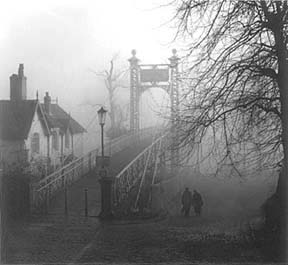  aving
returned
from
our
detour via
the Amphitheatre and St. John's
Church and
rejoined
the Newgate, we
take
leave
of
the
Roman
course
of
the
wall,
not
meeting
it
again
until St.
Martin's
Gate on
our
homeward
stretch,
and
now
enter
the
Saxon
extension
commenced
about
907
AD
by Aethelfleda,
countess
of
Mercia. aving
returned
from
our
detour via
the Amphitheatre and St. John's
Church and
rejoined
the Newgate, we
take
leave
of
the
Roman
course
of
the
wall,
not
meeting
it
again
until St.
Martin's
Gate on
our
homeward
stretch,
and
now
enter
the
Saxon
extension
commenced
about
907
AD
by Aethelfleda,
countess
of
Mercia.
The occupying Danes had been driven out of Chester by her father, Alfred the
Great and renovating the old fortress was part of Aethelfleda's continuing strategy
to resist their increasing incursions. It was establishment as
the centre of a line of burghs, stretching from Manchester to Rhuddlan,
to protect the northern frontier of Mercia.
It is said that she suffered excessive discomfort at the birth of her first
child and therefore avoided the embraces of her husband Ethelred for
the next fourty years, saying that "It was not fit for a King's daughter to
be given to a pleasure that brought so much pain along with it."
It seems her abstinence left her plenty of energy for other pursuits, among
which was the restoration and extension of Chester's defences after the harsh
treatment they had received during the preceding centuries- most recently by
the Danes:
"They marched without a halt by day and night, until they arrived at a deserted
Roman site in Wirral, called Chester. The English were unable to overtake them
before they got inside that fort, but they besieged it some days" (Anglo
Saxon Chronicle: AD894 )
It is surely a testament to the quality of the XXth Legion's defences that,
500 years after their departure, these occupying Norsemen could still find shelter
from an English army behind them.
However,
parts
of
the
walls had fallen
into
a state
of
decay,
and,
after
her
expulsion
of
the
invaders,
Ethelfleda
set
about
their
rebuilding
and
radical
enlargement.
Much
of
this
southern
section
is
said
to
be
her
work-
although
considerable
rebuilding
and
extension
was
also
later
undertaken
by
the
Normans- the entire city wall, for example, between the Grosvenor Bridge and the Water Tower was constructed by them.
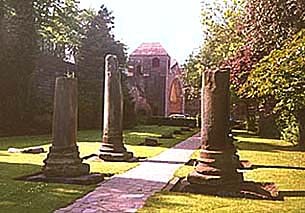 The new town developed into an important port known as Legeceastre- a
Saxon corruption of the latin Legio, a Legion and Castra, a fortress,
which in time became shortened to Chester. The new town developed into an important port known as Legeceastre- a
Saxon corruption of the latin Legio, a Legion and Castra, a fortress,
which in time became shortened to Chester.
Looking
down
on
the
outside
of
the
wall
you
can
see
the
so-called Roman
Garden- seen
here
before
its
restoration,
with
the Newgate in
the
background- in
which
is
displayed
a
motley
collection
of
ancient Roman
stonework,
including
assorted
columns
and
a
reconstructed hypocaust,
or
underfloor
heating
system-
which
have
been
unearthed
at
various
locations
around
the
town
and
reassembled
here. Chester's
ancient High
Cross was
for
many
years
displayed
here
also until pedestrianisation returned it to its ancient original location in the city centre.
First
mentioned
in
city
records
in
1377,
during
the
Civil
War,
the
Cross
had
served
as
a
rallying
point
for
the
Royalist
citzens,
but
after
their
eventual
surrender
to
Parliamentiary
forces
at
the
end
of
the
siege
in
1646,
it
was
feared
they
would
destroy
it,
an
ordinance
of
1643
having
called
for
the "utter
demolishing
of
all
monuments
of
superstition
and
idolatry". After
their
surrender,
the
citzens
had
received
reassurances
that
"no
church
within
the
city,
evidences
or
writings
belonging
to
the
same
shall
be
defaced" and
assumed
this
also
applied
to
the
Cross.
They
were
wrong,
and
it
was
demolished. The
ornate
top
section,
with
its
carved
figures
of
saints,
apostles
and
the
Virgin
Mary,
vanished
without
trace. The
base
of
the
Cross
ended
up,
around
1817,
at Plas
Newydd in
Llangollen,
North
Wales,
where
it
remains
to
this
day.
The
remainder
was
hidden
under
the
steps
of
nearby
St.
Peter's
Church,
and
stayed
there
forgotten
until
being
rediscovered
in
1820,
during
the
course
of
repairs.
A
churchwarden
placed
the
pieces
in
his
garden
in
Handbridge,
until
they
were
acquired
by
the
1st
Duke
of
Westminister
some
sixty
years
later,
who
had
them
placed
in
the
newly-opened Grosvenor
Museum.
The
city
council
re-erected
the
Cross
here in
the
Roman
Garden
in
1949- it can just be seen at the far left of this contemporary photograph.
With
the
coming
of
pedestrianisation,
it
was
restored
to
its
ancient
original
site
at
the
intersection
of
the
city's
main
streets
in
1975,
after
an
absence
of
some
329
years.
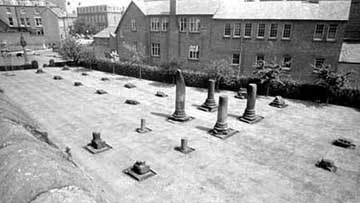 The Roman
Garden was
established
in
1949
by
Graham
Webster,
then
curator
of
the
Grosvenor
Museum,
and
Charles
Greenwood,
the
City
Engineer,
as
Chester's
contribution
to
the 1951
Festival
of
Britain.
Today
it
is
a
quiet
oasis
in
a
busy
part
of
the
city,
but
it
was
not
always
so
peaceful
here.
Standing
in
the
garden
and
looking
at
the
stretch
of
city
wall
visible
on
the
left
of
the
photograph
above,
through
the
shrubs
you
will
see
a
section "so
wide
that
six
horses
might
have
marched
up
in
rank" that
clearly
differs
from
the
masonry
around
it.
This
is
a
repaired
breach
made
by
Parliamentary
bombardment
from
the
churchyard
and
tower
of St. John's
Church in
September,
1645
during
the
Siege
of
Chester.
The
commander
of
the
Royalist
defending
forces, John,
first
Baron
Byron (an
ancestor
of
the
poet
Lord
Byron)
had
ordered
the
pulling
down
of
the
tower
to
avoid
just
such
a
situation-
an
order
which
was
never
carried
out.
His
stirring
account
of
the
bloody
events
that
took
place
here
includes
the
following: "Thrice
that
night
the
enemy
was
upon
the
top
of
the
wall,
but
at
last
quite
beaten
off.
Seven
of
them
were
killed...who
afterwards
fell
into
the
street,
and
were
the
next
day
buried
by
us.
There
were
some
of
them
taken
alive,
but
much
hurt, and
so
drunk
that
the
scent
of
them
was
most
offensive". The Roman
Garden was
established
in
1949
by
Graham
Webster,
then
curator
of
the
Grosvenor
Museum,
and
Charles
Greenwood,
the
City
Engineer,
as
Chester's
contribution
to
the 1951
Festival
of
Britain.
Today
it
is
a
quiet
oasis
in
a
busy
part
of
the
city,
but
it
was
not
always
so
peaceful
here.
Standing
in
the
garden
and
looking
at
the
stretch
of
city
wall
visible
on
the
left
of
the
photograph
above,
through
the
shrubs
you
will
see
a
section "so
wide
that
six
horses
might
have
marched
up
in
rank" that
clearly
differs
from
the
masonry
around
it.
This
is
a
repaired
breach
made
by
Parliamentary
bombardment
from
the
churchyard
and
tower
of St. John's
Church in
September,
1645
during
the
Siege
of
Chester.
The
commander
of
the
Royalist
defending
forces, John,
first
Baron
Byron (an
ancestor
of
the
poet
Lord
Byron)
had
ordered
the
pulling
down
of
the
tower
to
avoid
just
such
a
situation-
an
order
which
was
never
carried
out.
His
stirring
account
of
the
bloody
events
that
took
place
here
includes
the
following: "Thrice
that
night
the
enemy
was
upon
the
top
of
the
wall,
but
at
last
quite
beaten
off.
Seven
of
them
were
killed...who
afterwards
fell
into
the
street,
and
were
the
next
day
buried
by
us.
There
were
some
of
them
taken
alive,
but
much
hurt, and
so
drunk
that
the
scent
of
them
was
most
offensive".
If
you
were
to
view
the
approaching
south
east
corner
of
the
city
wall
from
outside,
you
would
be
able
to
see
clear
evidence
of
the
cannon
and
mortar
(grenado)
damage
inflicted
by
Parliamentary
guns
firing
from
the
chuch
and
from
across
the
river.
The
wall's
great
strength,
however,
ensured
its
survival-
give
or
take
the
odd
tower-
unlike
the
hundreds
of
lesser
structures
both
within
and
without
the
walls
which
were
destroyed
during
the
conflict. Randle
Holme
III's
despairing description of
the
devastated
city
after
the
long
siege
makes
for
exceedingly
grim
reading.
Truly,
for
all
its
present
wealth
of
venerable
buildings,
had
the
siege
never
occured,
Chester
would
be
able
to
boast
of
far
more
ancient
houses,
churches
and
great
halls
than
it
now
does.
But
we
are
fortunate
that
so
much
still
remains
with
us,
despite
the
ravages
of
ancient
armies
and
modern
developers...
The
walls
viewed
from
this
area
are
quite
magnificent
and
clearly
show
the
different
styles
of
masonry
employed
over
their
many
centuries
of
rebuilding
and
repairs.
The
ancient
lower
courses
on
this
corner
of
city
wall
are
now
so
weathered
it
is
difficult
to
distinguish
them
from
the
sandstone
bedrock
upon
which
they
stand.
Bowls and Cockfights
 For years, the
area
between
the
Roman
Garden
and
the Chester Groves public
house
(formerly known as Old Orleans) by
the
riverside
was, as may be seen here,
a
curiously
neglected
wasteland
containing
some
enigmatic
old
carved
column
bases-
and
a
lot
of
brambles. For years, the
area
between
the
Roman
Garden
and
the Chester Groves public
house
(formerly known as Old Orleans) by
the
riverside
was, as may be seen here,
a
curiously
neglected
wasteland
containing
some
enigmatic
old
carved
column
bases-
and
a
lot
of
brambles.
Chester
historian Frank
Simpson,
writing
in
1910,
described
the area as a "beautifully
laid-out
bowling
green",
and
also
that
"on
the
north
side
of
the
green
and
just
beyond
a
small
orchard,
stands
the
site
of
the
old cockpit".
In Batenham's Stranger's
Companion
in
Chester of
1823,
we
read
of
this
spot: "Looking
across
the
orchard
beneath,
we
see
the
venerable
tower
of St. John's
Church,
nodding
over
its
mouldering
base".
(It
fell
down
less
than
sixty
years
later
and
that
'mouldering
base'
is
all
that
remains)
"At
the
end
of
the
orchard,
under
the
wall,
is
a
mean
thatched
circular
building,
used
as
part
of
a
pipe-manufactory,
but
occupied
during
the
race-week
for
the
cruel
practice
of
cock-fighting",
the
charge
for
admission,
he
tells
us,
being
five
shillings
a
day.
"William,
sixth Earl
of
Derby,
in
1619
made
a
faire
cock-pit
under
St. John's
in
a
garden
by
the
riverside
to
which
resorted
gents
of
all
parts
and
great
cocking
was
used
a
long
while".
Long
after
its
disappearance
the
site
continued
to
be
known
as
'Cock-fight
Hill'.
This cruel 'sport' was engaged in at numerous locations around the town including several inns and the specially-built cockpit long existed in the Roman Garden. The wooden structure was replaced in 1825 by a brick building with a slate roof, paid for by the 'sportsmen' themselves. It became the custom during race weeks at the Roodee for 'gentlemen' to spend their mornings at the cock fights while their ladies visited the shops. So popular did the activity become that, should the cock fighting overrun, as occured in 1834, the start of the horse racing had to wait until it had finished! Finally officially banned in 1849, the sport went underground and doubtless continues up to the present day. In 1956, police raided a cock fight at Cotton Edmunds Farm at Waverton, a village near Chester, close to the site of today's popular Crocky Trail and made 36 arrests, including 13 local farmers.
As recently as 1972, the Chester Riverside Study told us that "the bowling green at Queen's Park Bridge... is very attractive and well-used, and should remain". Unfortunately, soon afterwards, the land was sold and the new pub was built on part of the site- where some unsightly metal boathouses formerly stood- and the rest was allowed to revert to wilderness.
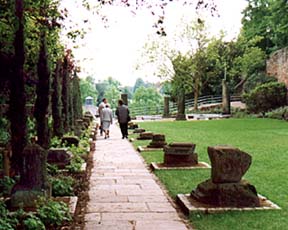 In
May
1997, however,
the
local
press
reported
the
welcome
news
that
Chester
City
Council
were
to
create
a new
park on
Cock-Fight
Hill!
The
owners
of
the
pub
on
the
Groves,
Scottish
and
Newcastle
Breweries,
had
generously donated
the
land,
on
the
provision
that
it
should
be
used
for
public
recreation.
The
fence
separating
it
from
the
Roman
Garden
was
to
be
removed,
a
new
path
linking
the
city
centre
to
the
Groves
created
and
the
old
gateway
through
the
walls
into
Park
Street-
at
the
time
effectively
lost
behind
the
brambles-
to
be
re-opened.
It
was
proposed
that
the
area
be
named Cockpit
Park and
it
was
to
feature
a
circle
of
stone
columns
topped
with
bronze
cockerels
(!)
to
mark
the
site
of
the
ancient
cockpit.
As
it
turned
out,
neither
of
these
proposals
were
acted
upon. In
May
1997, however,
the
local
press
reported
the
welcome
news
that
Chester
City
Council
were
to
create
a new
park on
Cock-Fight
Hill!
The
owners
of
the
pub
on
the
Groves,
Scottish
and
Newcastle
Breweries,
had
generously donated
the
land,
on
the
provision
that
it
should
be
used
for
public
recreation.
The
fence
separating
it
from
the
Roman
Garden
was
to
be
removed,
a
new
path
linking
the
city
centre
to
the
Groves
created
and
the
old
gateway
through
the
walls
into
Park
Street-
at
the
time
effectively
lost
behind
the
brambles-
to
be
re-opened.
It
was
proposed
that
the
area
be
named Cockpit
Park and
it
was
to
feature
a
circle
of
stone
columns
topped
with
bronze
cockerels
(!)
to
mark
the
site
of
the
ancient
cockpit.
As
it
turned
out,
neither
of
these
proposals
were
acted
upon.
In
January
1999,
a
brief
archaeological
investigation
of
the
site
took
place,
followed
in
May-
two
years
after
the
plans
were
announced-
by
an
official
'turf
cutting'
ceremony. Funding for the project came partly from a £100,000 bequest by the late Sally,
Duchess of Westminster- aunt of the present Duke- Capital Bank contributed £80,000
and the remaining £20,000 from the city's Capital Challenge Fund. The
late
Duchess
had travelled
the
world
in
search
of
rare
and
unusual
plants
and
was
very
involved
with
the
development
of
the
gardens
at Chester
Zoo.
City Council Landscape Officer Tom Walker said of the project, "The new park
is to contain features that explain the fascinating history of the area. It's
not just a building project, but a voyage of discovery... a tremendously exciting
project which will generate a great deal of interest for local people and visitors".
The
new
park-
illustrated
above-
is
now
complete.
We're
sure
you'll
ageee
that
it
all
looks
most
impressive,
down
to
the
marble
benches
and
newly-planted
cypress
trees and other plants originating in the Roman world. But
visitors
should
be
aware
that
this
so-called
Roman
Garden,
attractive
as
it
is,
remains
little
more
than
a
pretty
sham,
whereas,
unforgivably,
while
work
on
it
was
going
on,
the genuine
article-
the
unexcavated
half
of
Chester's
great
Roman amphitheatre right
next
door-
was
overrun
with
excavating
machines,
preparing
the
ground
for
a
new
office
and
court
complex
with
associated
car
park
to
be
erected
on
top
of
it! Your
guide,
together
with
all these correspondents,
wondered
at
the
rationale
of
a
local
authority
that
could
allow-
even
defend-
such
an
act
of
desecration...
Visitors to the Roman Garden will notice the rich variety of mosaics to be seen there. Despite appearances, these are all quite recent additions. The oldest, the large circular work at the garden's entrance, was commissioned by the Chester Civic Trust to commemorate the society's Golden Jubilee in 2010. The others are the work of mosaic artist Gary Drostle (who was also responsible for the mural at the nearby amphitheatre) and were put in place here as recently as the end of 2011. One contains a 'four seasons' design that was based on a mosaic from Chebba in Tunisia, now preserved in the Bardo Museum in Tunis. The hypocaust mosaic is fitted within the existing York stone paving to give the impression that it has been partially excavated in situ. It is a reproduction of the Ostia style mosaic work discovered in the great bath house complex that was discovered when the ground was being prepared for the construction of the Grosvenor Precinct and tragically destroyed soon afterwards.
Bidding farewell to the Roman Garden and returning to the city wall,
on
the
corner
of
Park
Street,
we
can
see
an
ugly
modern
multi-storey
car
park
surmounted
by
a
large
stone
lion
which
once
stood
on
the
top
of
the Lion
Brewery,
the
former
occupant
of
the
site.
A
little
further
on
is
a
striking
medieval-style
timber
house
by
W. H. Kelly,
built
as
recently
as
1881,
which
bears
the
legend, "The
Fear
of
the
Lord
is
a
Fountain
of
Life",
said
to
be
the
inscription
on
an
ancient
coin
found
on
the
site.
Less
romantically,
the
building
currently
houses
a
dental
surgery.
Next,
we
come
to
a
fine
row
of
17th
century
former
almshouses
known
as
the Nine
Houses-
though
actually
only
six
remain
today.
Aspiring
residents
of
these
cottages
had
to
be
over
65
years
old
and
abstain
from
tobacco
and
alcohol-
unlike
the
more
fortunate
occupants
of
the
almshouses
behind
the Bluecoat near
the
Northgate,
whose
daily
fare
included "A
loaf
of
bread,
a
dish
of
pottage, half
a
gallon
of
competent
ale and
a
piece
of
fish
or
flesh,
as
the
day
shall
require".
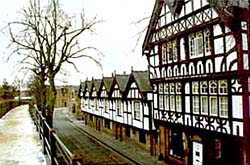 Each
house
has
a
gable
spanning
the
timber-framed
upper
storey,
which
extends
out
from
the
sandstone
ground
floor-
an
unusual
arrangement
in
Chester,
where
the
ground
floors
of
the
old
buildings
beyond
the
rows
more
often
have
timber
framing
on
sandstone
plinths. Each
house
has
a
gable
spanning
the
timber-framed
upper
storey,
which
extends
out
from
the
sandstone
ground
floor-
an
unusual
arrangement
in
Chester,
where
the
ground
floors
of
the
old
buildings
beyond
the
rows
more
often
have
timber
framing
on
sandstone
plinths.
The
Nine
Houses
had
been
allowed
to
fall
into
disrepair
over
the
years,
and
narrowly
avoided
being
destroyed
in
the
1960s.
Remarkably,
in
a
period
not
noted
for
its
sympathetic
treatment
of
ancient
buildings-
the
fine
Victorian Market
Hall had
been
demolished
amid
fierce,
and
continuing,
controversy
the
year
before.
A
grant
was
obtained
and
a
complete
restoration
was
undertaken
in
1968.
Local
historian, Bernard
Wall- who sadly died in April 2002-
took
exception
to
the
view
that
these
were
ever
almshouses,
however,
stating
that
they
had
always
been
defined
as
'dwellings'
ie
family
houses.
He
said
he
personally
knew
a
lady
who
had
raised
her
family
there.
In
the
1960s,
a
row
of
actual
almshouses
on
Pepper
Street
on
the
site
of
today's
Conservative
Club
close
to
the
present Police
HQ were
demolished
to
make
way
for
the Inner
Ring
Road and
their
occupants
were
transferred
to
the
Nine
Houses
after
they
had
been
renovated.
Immediately
after
the
Nine
Houses,
we
see
the splendid Albion
Inn,
run for many years by landlord Mike Mercer and a
fine
example
of
that
rare
and
eccentric
thing,
a
true
English
pub-
real
fires,
real
ale,
a piano, no
jukebox
or
bigscreen
TV-
and
an
opportune
spot
for
us
to
rest
and
partake
of
refreshments.
Be
aware however,
that
a
sign
outside
the Albion declares "when we're open we're open, when we're closed we're closed"- the Albion is now probably unique in
closing its doors in the afternoon, as all British pubs were once compelled to do- and that it is "family
hostile"-
one
of
a
dwindling
number
of
British
pubs
that
does
not
welcome
children. For the rest of us, however, the beer, food and atmosphere are superb..
Just
opposite
the
Albion
is
a
ramp
which
will
allow
you
easy
access
to
and
from
the
City Wall.
You
will
also
notice
the
previousy long sealed-up door
through
the
wall
here
leading
to
Cockpit
Hill,
as
discussed above.
The
well-maintained
terraced
houses
found
here
in
Albion
Street
and
Duke
Street
were
erected
between
1865
and
1869
on
the
former
bowling
green
and
pleasure
gardens
of
the
old Talbot
Hotel (formerly
Park
House)
of
1715,
which
formerly
stood
in
Lower
Bridge
Street.
Around
the
same
time,
the
17th
century Harvie's Almshouses which
formerly
stood
in
Duke
Street
were
demolished.
The
handsome
turreted
building
you
can
see
at
the
end
of
Albion
Street
is
the Volunteer
Drill
Hall, built
in
the
Gothic
style
in
1869
as
the
HQ
of
the
2nd
volunteer
battalion
of
the
Cheshire
Regiment. It was, a few years ago,
converted
for
residential
use and now stands, curiously, surrounded by those Victorian terraced houses.
Looking again to the Walls, as we turn the south-east corner we encounter a widening of the walkway into what was once a prominent watchtower which went by the name of Barnaby's Tower. It was probably first built in the 13th century and stands on an outcrop of sandstone, which is clearly visible from the base of the wall. It was seriously damaged by Parliamentary cannon and grenado fire during the terrible English Civil War Seige of Chester (1644-6), some of the damage caused by the missiles still being clearly visible today. Although most of the tower above the walkway was destroyed at this time, the remainder was retained as a feature of the promenade which was created along the Walls in 1702-8. Made of coursed red sandstone rubble, the bastion forms a 3-sided projection from the wall. The parapet was 'improved' at the expense of Councillor Charles Brown (who also laid out the beautiful riverside walk known as The Groves which we see below us) in 1879-80 when the mock-medieval crenellations were created.
Our
exploration
of
the
Walls
of
Chester
now
take
us
down
to
the
delights
of
the River
Dee..
Curiosities from Chester's History no. 15
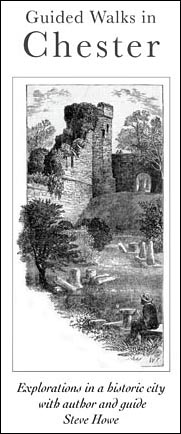 1576
The
Privy
Council
ordered
the
Mayor
to
discharge
a
man
confined
in
the Northgate Gaol,
for
asserting
that Queen Elizabeth had
two
bastards
by Robert Dudley, Earl of Leicester.
Complaints
from
the
citizens
regarding
the
massive
heaps
of
dung
deposited
by
cattle,
horses,
pigs,
hens,
dogs
and
other
creatures
which
roamed
the
streets,
prompting
the
city
council
to
order
its
removal
by
the
beast's
owners,
on
pain
of
a
fine
of
3s
3d. 1576
The
Privy
Council
ordered
the
Mayor
to
discharge
a
man
confined
in
the Northgate Gaol,
for
asserting
that Queen Elizabeth had
two
bastards
by Robert Dudley, Earl of Leicester.
Complaints
from
the
citizens
regarding
the
massive
heaps
of
dung
deposited
by
cattle,
horses,
pigs,
hens,
dogs
and
other
creatures
which
roamed
the
streets,
prompting
the
city
council
to
order
its
removal
by
the
beast's
owners,
on
pain
of
a
fine
of
3s
3d.
- 1577
For
failing
to
provide
the
citizens
with
a
sufficient
quantity
of
meat
and
"forming
a
confederacy
against
the
sale
of
meat
by
County
butchers"
the
entire
Company
of
Butchers
was
committed
to
the
Northgate,
but
were
released
four
days
later
on
account
of
the
intolerable
heat
in
the
small
cramped
gaol,
and
also
"because
their
wives
were
very
upset".
Before
being
released,
they
gave
a
promise
that
they
would
in
future
serve
the
City
faithfully.
Nevertheless,
butchers
from
outside
the
city
were
first
allowed
to
trade
in
Chester
this
year.
390
beer
trading houses
in
Cheshire.
- 1578
400
soldiers
rioted
among
themselves
while
stopped
overnight
at
Chester
en
route
for
Ireland.
In
order
to
stop
the
revolt,
the
Mayor
imprisoned
both
Captains
in
the
Northgate
Gaol
and
the
city
was
put
under
martial
law
until
order
was
restored.
- 1579 Watergate
Street,
from
the
High
Cross
to
Trinity
Street,
paved
for
the
first
time.
- 1580
Arms
granted
to
the
city
bearing
the
motto Antiqui
Colant
Antiquum
Dierum ('Let
the
ancients
honour
the
Ancient
of
Days')
Saturday
25th
Feb:
a
total
ecplipse
of
the
sun
occured:
"the
like
was
never
seen
in
the
memory
of
man".
- 1581
Queen
Elizabeth
gave St.
John's
Church to
its
parishioners
and
they
began
to
restore
it,
including
cutting
off
the
ruined
east
end
and
all
the
chapels
above
the
Choir
with
a
new
wall.
The
City
Magistrates
bought
the
old
Shire
Hall
in
the Castle for
six
Cheshire
cheeses,
and
moved
it
to
the Market
Square where
it
was
first
served
as
a
granary,
and
was
then
appropriated
by
the
city's
butchers,
and
became
the
'flesh
shambles'.
Sedan
chairs
in
general
use
in
England.
- 1582
The Gregorian
calendar adopted
in
the
Papal
States,
Spain,
Portugal,
France,
the
Netherlands
and
Scandinavia.
Not
used
in
England
until
1752
- 1583
The
Sheriff
ordered
that
the
crosses
which
stood
at
the
Bars,
the
Northgate
and
the
Spital
were
to
be
pulled
down.
Shortly
after
this
order
was
carried
out,
this
Sheriff
died,
and
the
Papists
attributed
this
action
as
being
the
cause
of
his
death.
First
known
life
insurance
in
England,
on
the
life
of
one
William
Gibbons
- 1584
The
'Horse
Pool'
in
the
Abbey
Courtyard
was
filled
in.
Money
was
"payed
to
Hugh
the
Skinner
for
for
carriage
of
the
filth
before
the
Gate
to
fill
the
hole
in
ye
court".
Dreadful
hailstorm:
much
damage
done
to
the
Dee
Mills
by
floods;
many
cattle
killed
by
lightning.
- 1585
Sixteen
pirates
stole
a
ship
from
Wirral,
and
killed
a
man;
the
wind,
forcing
the
vessel
back,
they
were
apprehended
and
committed
to
the
Northgate.
Eastgate
Street
was
re-paved.
The Old
Dee
Bridge collapsed
and
two
horses
and
some
cattle
pulling
loads
of
coal
were
drowned.
- 1586
A
'hue
and
cry'
throughout
the
land
that
Chester,
London
and
Bristol
had
been
set
on
fire
by
the
Papists,
and
that
"a
navye
of
700
Spanish
shippes"
had
landed
"at
the
New
Quay
in
Wirral".
The
rumour
proved
groundless.
The Roodee was
leased
to
a
wealthy
citizen,
on
condition
that
games
and
plays
would
still
be
allowed
on
it
as
before.
Bridge
Street
was
re-paved.
(A
fine
new
cobbled
surface
was
laid
in
Bridge
Street
in
Spring
1999)
- 1587
A
man
named
Harvey
from
Knutsford
was hung,
drawn
and
quartered* for
the
crime
of
'clipping
money',
and
his
quarters
set
on
the
four
Gates.
The
Mayor
ordered
that "a
public
faste
to
be
kepte
2
days,
Wensday
and
Fridaye,
from
eight
in
the
morninge
till
eleven,
and
at
one
of
the
clock
till
five
at
nyghte-
in
regards
we
had
very
unseasonable
weather
and
other
troubles
in
the
realme.
This
was
proclaimed
by
command
of
said
Mr
Maior,
which
no
doubte
did
great
goode". Mary,
Queen
of
Scots executed
at Fotheringhay Castle.
- 1588
The
defeat
of
the Spanish
Armada.
Public
holiday
declared.
The
Mayor
and
Corporation
of
Chester
attended
the Cathedral in
full
ceremonial
robes
and
received
Holy
Communion.
- 1589
A
woman
burnt
at Boughton for
poisoning
her
husband.
John
Taylor,
Keeper
of
the
Castle
Gaol,
was
hung
for
killing
Mr.
Hockenhall,
a
prisoner.
The
City
Walls
were
again
reported
to
be
in
a
"crumbling
and
ruinous
condition".
£100
was
collected
by
public
subscription
for
their
repair
- 1590
The
privateer, Harry
Bonoventure, manned
with
60
crew
and
12
guns
sets
out
from
Chester
"To
be
used
in
warlike
manner
agaynst
the
Kinge
of
Spayne"
* This
most
horrible
and
barbaric
of
punishments
prevailed
for
hundreds
of
years
in
England
for
the
most
serious
of
crimes-
most
notably
High
Treason.
It
involved
the
unfortunate
criminal
being
dragged
around
the
town,
and
from
there
to
the
place
of
execution
(in
Chester's
case Boughton,
a
mile
or
so
outside
the
Eastgate)-
on
a
wooden
sledge
or
pallet,
being
there
hung
for
a
short
period,
but
cut
down
while
still
conscious,
then
having
his
private
parts
cut
off
and
burned
before
his
eyes,
followed
by
his
belly
being
slit
open
and
his
bowels
similarly
burned.
Trouble
was
taken
to
ensure
the
victim
remained
conscious
and
observant
throughout
the
process,
which
was
witnessed
by
large
crowds.
Finally,
he
was
beheaded
and
his
torso
roughly
chopped
into
four
pieces
which,
together
with
his
head,
would
be
publicly
displayed-
after
being
sprinkled
with
certain
spices
to
prevent
the
birds
pecking
at
it-
in
prominent
positions
around
the
town,
such
as
upon
the
city
gates-
or
even
in
different
cities
throughout
the
country... |